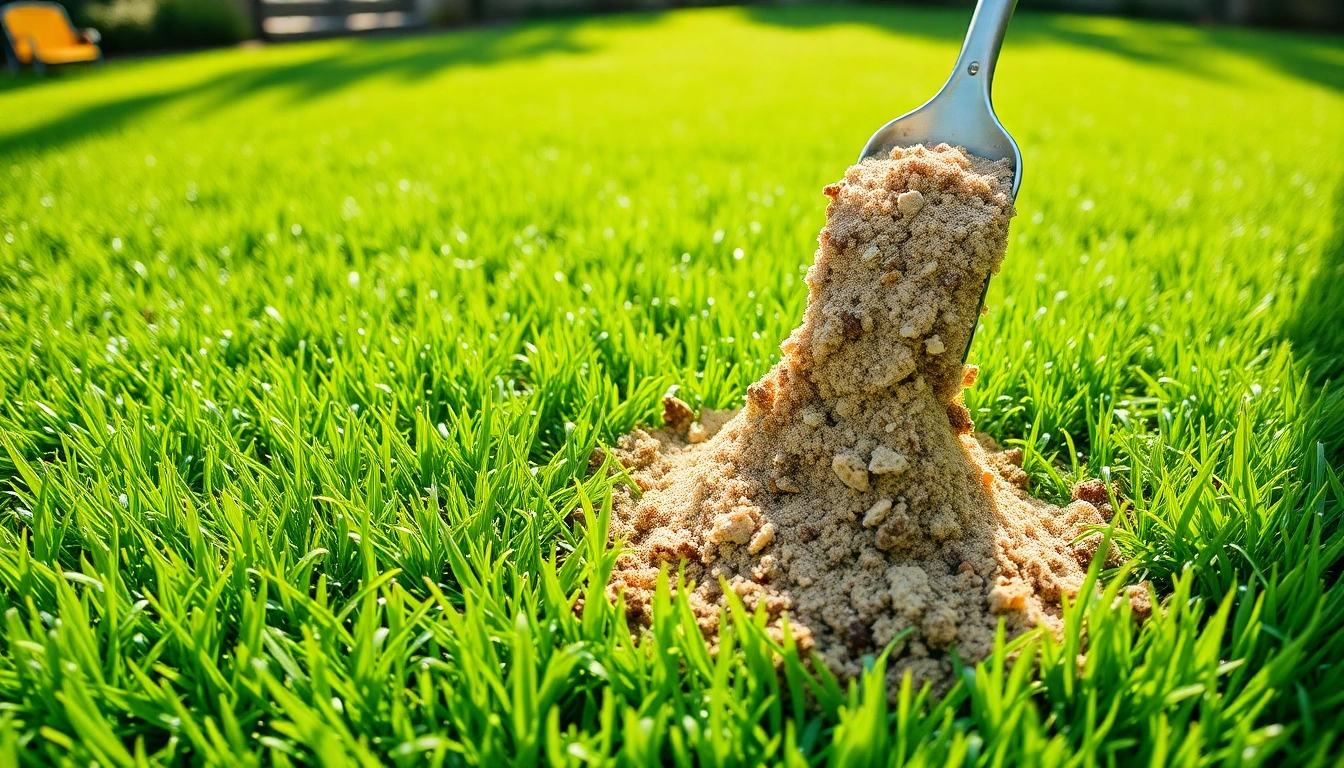Essential Guide to Lawn Top Dressing: Boost Your Lawn’s Health and Appearance
Understanding Lawn Top Dressing
Lawn top dressing is a fundamental practice in lawn maintenance that contributes significantly to the health and aesthetic appeal of your turf. This process involves adding a thin layer of nutrient-rich materials, such as compost or soil, over the existing lawn. Such a straightforward task may seem inconsequential; however, understanding the nuances of lawn top dressing can transform an average lawn into a lush, green landscape. For those new to this concept, lawn top dressing is essential for fostering robust growth and ensuring even soil nutrition for your grass. Let’s explore its fundamental aspects.
What is Lawn Top Dressing?
Lawn top dressing is the application of a thin layer of material—often comprising compost, loam, and sand—over the grass surface. It serves a multitude of purposes, such as improving soil structure, enhancing drainage, and replenishing nutrients in the existing soil. The goal is not to smother the grass but to subtly enrich the living ecosystem of your lawn while providing a balanced foundation for optimal growth.
Benefits of Top Dressing Your Lawn
Implementing lawn top dressing provides numerous benefits:
- Nutrient Supply: Finished compost, a common material for top dressing, is rich in nutrients that support healthy grass growth.
- Improved Soil Structure: Top dressing helps improve soil structure. It encourages microbial activity, enhancing aeration and water retention capabilities.
- Leveling Uneven Areas: It is particularly effective for leveling minor bumps and dips in your lawn, yielding a more aesthetically pleasing appearance.
- Weed Reduction: A healthy layer of well-composted material can inhibit weed growth and discourage weed seedlings from establishing themselves.
- Pest Management: By promoting strong, healthy grass, top dressing can create an environment that is less hospitable to pests, making your lawn more resilient.
When to Top Dress Your Lawn
The timing of your top dressing application can significantly impact its effectiveness. Here are key considerations for when to perform this lawn care technique:
- Spring: Best for general replenishment and leveling, just before the growing season starts.
- Fall: Ideal for lawns that have undergone heavy use during the summer, particularly for cool-season grasses.
- After Aeration: For optimal results, top dress immediately after aerating to allow nutrients to penetrate and support recovery.
Materials Used in Lawn Top Dressing
The effectiveness of lawn top dressing greatly depends on the materials chosen. Picking the right combination can lead to significant enhancements in lawn health and performance.
Best Soil Mixtures for Top Dressing
The best soil mixture for top dressing typically includes a combination of the following elements:
- Compost: Essential for providing nutrients and improving soil structure. It should be finely screened to avoid large clumps that can smother grass.
- Sandy Loam: A balanced blend of sand, silt, and clay, which allows for excellent drainage and aeration while retaining moisture effectively.
- Sharp Sand: Useful in mixing for improving drainage and lightening heavier soil textures, enhancing root growth.
Compost versus Other Top Dressing Materials
Compost is often hailed as the best material for top dressing; however, it is not the only option. Here’s how compost stacks up against other materials:
- Compost: Rich in organic matter, compost rejuvenates the soil, providing necessary nutrients, and contributes to microbial activity.
- Topsoil: While it can be useful, over-reliance on topsoil, especially if not carefully sourced, can introduce weeds and pests.
- Sand: Particularly beneficial for heavy clay soils to improve drainage but must be used in moderation; excessive sand can lead to a dry, unproductive environment.
Accessibility of Top Dressing Ingredients
Accessibility to quality materials is critical. Here are a few options for sourcing top dressing ingredients:
- Local Garden Centers: Often carry soil mixes suitable for top dressing.
- Bulk Suppliers: Great for larger projects, many suppliers provide custom blends tailored for local soil conditions.
- DIY Composting: For the eco-conscious lawn enthusiast, creating your own compost can be a rewarding and cost-effective way to gather top dressing material.
Step-by-Step Lawn Top Dressing Process
A well-executed top dressing can revitalize your lawn and promote healthy growth. Below, we outline a comprehensive, step-by-step guide for successfully top dressing your lawn.
Preparation and Tools Needed
Preparation is key to effective top dressing. Ensure you have the following tools:
- Quality top dressing mix (preferably a combination of compost and sandy loam)
- A lawn aerator (manual or powered)
- Spreaders (broadcast spreader or drop spreader)
- A rake for leveling
- A garden hose or irrigation system for watering
Before applying top dressing, mowed grass should ideally be about 2 to 3 inches high. Aerating the lawn one to two days before top dressing will help ensure adequate soil contact and nutrient absorption.
Applying Lawn Top Dressing Properly
Follow these steps to properly apply top dressing:
- Aerate the Lawn: Use a lawn aerator to create holes in the soil, allowing the top dressing to penetrate more effectively.
- Evenly Spread the Top Dressing: Use a spreader to apply the top dressing mix uniformly over the lawn. Aim for a layer no thicker than 1/4 to 1/2 inch.
- Level the Surface: After spreading, use a rake to gently level any areas that appear uneven, ensuring the grass blades remain visible.
- Water Thoroughly: Lightly water the lawn post-application to help the mix settle and encourage absorption by the soil.
Post-Top Dressing Care
After top dressing your lawn, take the following measures to ensure optimal growth:
- Continue regular watering, especially during dry spells, to help seedlings and existing grasses recover and thrive.
- Limit foot traffic until the lawn has fully recovered, which could take two to four weeks depending on conditions.
- Monitor for signs of pest issues or diseases, as the nutrient-rich top dressing could temporarily attract pests.
Common Mistakes to Avoid When Top Dressing Your Lawn
While top dressing can be highly beneficial, certain common mistakes can hinder its effectiveness. Being aware of these pitfalls will help ensure successful application.
Overloading the Lawn with Material
One of the primary mistakes homeowners make is applying too much top dressing. A layer thicker than the recommended 1/4 to 1/2 inch can suffocate the grass and stifle growth. Always exercise caution to avoid smothering existing grass.
Ignoring Soil and Grass Needs
Every lawn is different, and understanding your soil type and grass variety is crucial. Ignoring these specifics can lead to poor results. For example, using a sandy mix for a moisture-retaining soil or applying compost that’s not finished can lead to undesirable outcomes.
Neglecting the Timing for Top Dressing
Timing is everything. Failing to apply top dressing during the optimal growth season can lead to poor grass recovery and health. Ensure that you target early spring or fall when grass is actively growing.
Advanced Lawn Top Dressing Techniques
Once you’ve grasped the basics of lawn top dressing, several advanced techniques can further enhance your lawn care practices.
Top Dressing for Specific Grass Types
Different grass types may have varying requirements. For instance:
- Bermudagrass: Thrives with a nitrogen-rich compost top dressing applied in late spring.
- Fescue: Should receive top dressing in the fall, prioritizing moisture retention and soil aeration.
- Zoysiagrass: Benefits from a light top dressing in the spring for disease prevention and a lush appearance.
Using a Top Dressing Spreader Effectively
A top dressing spreader can help achieve an even application of material over the lawn. Ensure settings are well-tuned; a common mistake is using the wrong spreader setting which can lead to under- or over-application. Experiment with pattern and speed to find the most effective method for your lawn’s size and layout.
Integrating Top Dressing with Other Lawn Care Practices
To maximize benefits, integrate top dressing with other lawn care practices. Consider combining it with overseeding to enhance nutrient provision and boost new grass establishment. Furthermore, regular aeration can complement top dressing, facilitating a healthy and resilient lawn.














Post Comment